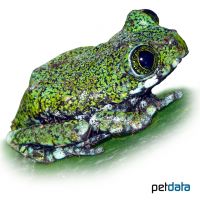Peacock Tree Frog (Leptopelis vermiculatus)
| Peacock Tree Frog Leptopelis vermiculatus | |
|---|---|
| Name | Peacock Tree Frog |
| Name Lat. | Leptopelis vermiculatus |
| Family | Arthroleptids |
| Family lat. | Arthroleptidae |
| Order | Frogs & Toads |
| Order lat. | Anura |
| Origin | Africa |
| Habitat | Rainforest |
| Diet | Small live insects |
| Humidity | 70-100 % |
| Behavior | ♂ territorial |
| Keeping | Pair, group |
| Care Level | Difficult |
| Breeding | Moderately difficult |
| Housing | Rainforest terrarium |
| Life Span | 5 years |
| Protection | No |
| Metric Units | |
| Size | 7 cm |
| Temperature | 24-28 °C |
| Housing Size | 40 x 40 x 60 cm |
| US Units | |
| Size | 2.8" |
| Temperature | 75-82 °F |
| Housing Size | 15" x 15" x 25" |
Distribution and habitat
The nocturnal blue-footed woodland frog occurs in some small mountainous regions of East Africa that are geographically very isolated from each other. It is found near waterholes, in mountainous areas of eastern Tanzania, the Usambara Mountains, Nguu Mountains, Udzungwa Mountains, Poroto Mountains, and the Mount Rungwe area near the border with Zambia.
Maintenance
For 1-2 animals, the minimum area of the terrarium is 1,600 cm² with a minimum effective height (measured without substrate) of 50 cm. This corresponds to a base area of e.g. 40 x 40 cm. For each additional animal, an additional 500 cm² area and 3 cm height must be provided. The terrarium should be placed in a quiet place without sunlight.
You need a terrarium with a substrate of loose, absorbent, non-rotting substrate such as sand-peat mixture, coconut fibers or sphagnum moss with a drainage, plus pieces of bark, flat stones, strongly branched climbing branches, preferably entwined with climbing plants, a dense planting (e.g. Tradescantia, Ficus, Hoya, Bromeliads) and a shallow water basin. Potted plants that can be easily removed for cleaning are advantageous. At least twice a day, except during seasonal dry periods, the inside of the terrarium must be finely sprayed with water (humidity), but a rain or mist system is better
| Temp. day: 24-28 °C | Temp. night: 18-22 °C | Humidity: 70-100 |
The lighting duration must be 10-14 hours depending on the season. Very suitable are daylight fluorescent tubes with low UV content, supplemented with spotlights.
During the seasonal dry period (3-5 months) the humidity is reduced to 50-80 %.
Diet
The food supply consists of live insects such as crickets, small grasshoppers and crickets, as well as mealybug larvae and cockroaches. After a period of habituation (feeding with tweezers), special ready-made food is often accepted as well. Food should be offered to adult animals 2-3 times per week, young animals must be fed daily. It is important to add minerals and vitamins regularly (e.g. by dusting the food animals).
A varied diet promotes health and prevents deficiency symptoms.
Reproduction and breeding
Males are smaller than females. Egg laying takes place near bodies of water. The larvae (tadpoles) hatch after 5-6 days and wriggle into the nearby water. They feed exclusively on plant food. After about 3 months the transformation (metamorphosis) is completed and the frog leaves the water.
Important
They emit characteristic sounds (clack) and are very adept at climbing with their fingers and toes widened into adhesive discs. Their mucous membrane is very sensitive, so care must be taken to maintain the necessary humidity and maximum cleanliness. Males occupy small territories, which are defended against intruders.
Before purchasing, a terrarium should be prepared that meets the species specific needs. Good ventilation without drafts and equipment for measuring temperature and humidity are necessary. The lighting has to correspond to the species-specific day-night rhythm and should be placed in such a way that the animals cannot injure themselves. The terrarium should be locked in such a way that neither unauthorized persons can open it nor the animals can escape. Special attention must be paid to thorough hygiene and impurities must be removed regularly
Further literature can be found in your pet store.
References
Text: petdata; Image: petdata
Source: ENGELMANN (2006): Zootierhaltung - Tiere in menschlicher Obhut: Reptilien und Amphibien, Harri Deutsch Verlag; VDA & DGHT (2006): Haltungsrichtlinien für die Haltung von Anuren
- Gemäß § 21 Abs. 5 Tierschutzgesetz idgF
